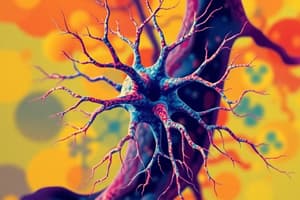Podcast
Questions and Answers
¿Cuál es la función principal de las dendritas en una neurona?
¿Cuál es la función principal de las dendritas en una neurona?
- Recibir señales de otras neuronas o receptores sensoriales. (correct)
- Producir energía para la célula.
- Transmitir información hacia el cuerpo celular.
- Enviar señales hacia otras neuronas o músculos.
¿Cuál es la estructura que se encarga de enviar señales hacia otras neuronas o músculos?
¿Cuál es la estructura que se encarga de enviar señales hacia otras neuronas o músculos?
- Axón (correct)
- Núcleo celular
- Dendritas
- Sinapsis
¿En qué parte de la neurona se libera neurotransmisores para comunicarse con otras neuronas?
¿En qué parte de la neurona se libera neurotransmisores para comunicarse con otras neuronas?
- Núcleo celular
- Axón
- Botón terminal o telodendrón (correct)
- Dendritas
¿Cómo se denominan las células especializadas que transmiten información a través del cuerpo mediante impulsos eléctricos?
¿Cómo se denominan las células especializadas que transmiten información a través del cuerpo mediante impulsos eléctricos?
¿Qué tipo de neuronas recolectan información del entorno externo a través de órganos sensoriales como ojos, oídos y piel?
¿Qué tipo de neuronas recolectan información del entorno externo a través de órganos sensoriales como ojos, oídos y piel?
¿Qué tipo de neuronas envían información desde el sistema nervioso central a células efectoras como músculos o glándulas?
¿Qué tipo de neuronas envían información desde el sistema nervioso central a células efectoras como músculos o glándulas?
¿Cuál es la función principal de las interneuronas en el sistema nervioso?
¿Cuál es la función principal de las interneuronas en el sistema nervioso?
¿Qué tipo de neuronas se encargan de llevar información sensorial al sistema nervioso central?
¿Qué tipo de neuronas se encargan de llevar información sensorial al sistema nervioso central?
¿Cuál es el papel de las neuronas motoras en la contracción muscular?
¿Cuál es el papel de las neuronas motoras en la contracción muscular?
¿Dónde se localizan principalmente las interneuronas dentro del sistema nervioso?
¿Dónde se localizan principalmente las interneuronas dentro del sistema nervioso?
Flashcards are hidden until you start studying
Study Notes
Neurons
Neurons are specialized cells that transmit information throughout the body via electrical impulses called action potentials. These cells have several key features that allow them to perform their functions effectively:
-
Cell Body: This is the central part of the neuron where most cellular processes occur. It contains the nucleus, which holds genetic material, and organelles such as mitochondria for energy production.
-
Dendrites: These are short, branching extensions of the cell body that receive signals from other neurons or sensory receptors. They are responsible for transmitting incoming information to the cell body.
-
Axon: A single, often very long extension of the cell body that sends signals outward to other neurons or muscles. Axons can range from just a few millimeters to over a meter in length.
-
Synapses: The junctions between axons and dendrites or muscle fibers, where communication between neurons takes place. Synapses release neurotransmitters, chemical messengers that relay signals across the synaptic cleft.
There are three main types of neurons, each with specific roles in processing and transmitting information:
Sensory Neurons
These neurons collect information from the external environment through sensory organs like eyes, ears, nose, tongue, and skin. Once stimulated by external factors such as light, sound, taste, touch, temperature, or pain, sensory neurons send this information to the central nervous system (CNS) — the brain and spinal cord — via their axons. Examples of sensory neurons include retinal ganglion cells, cochlear nerve cells, olfactory receptor cells, gustatory nerve cells, and somatosensory nerve cells.
Motor Neurons
Motor neurons convey information from the CNS to effector cells, which may be muscles or glands. When activated by the CNS, these neurons cause effector cells to contract or secrete chemicals, resulting in movement or other physiological responses. There are two main classes of motor neurons: upper motor neurons, which originate in the motor cortex and project to lower motor neurons; and lower motor neurons, which directly innervate skeletal muscles, smooth muscles, cardiac muscles, or glands.
Interneurons
Interneurons, also known as association neurons, are located within the CNS and play a crucial role in integrating and modifying information before it reaches its target. They act as intermediate relays between sensory neurons and motor neurons, forming complex neural circuits that enable us to process, analyze, and respond to our surroundings. Interneurons help integrate multiple inputs into a coordinated response and refine or filter information before sending it on to other parts of the nervous system. Examples of interneurons include Purkinje cells in the cerebellum, pyramidal neurons in the cerebral cortex, and Renshaw cells in the spinal cord.
Studying That Suits You
Use AI to generate personalized quizzes and flashcards to suit your learning preferences.




